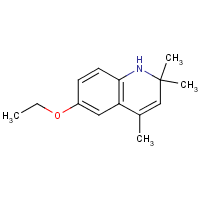Ethoxyquin
Agent Name
Ethoxyquin
CAS Number
91-53-2
Formula
C14-H19-N-O
Major Category
Other Uses

Synonyms
1,2-Dihydro-2,2,4-trimethyl-6-ethoxyquinoline; 1,2-Dihydro-6-ethoxy-2,2,4-trimethylquinoline; 2,2,4-Trimethyl-6-ethoxy-1,2-dihydroquinoline; 6-Ethoxy-1,2-dihydro-2,2,4-trimethylquinoline; 6-Ethoxy-2,2,4-trimethyl-1,2-dihydroquinoline; Alterungsschutzmittel EC; Amea 100; Antage AW; Antioxidant EC; Aries Antox; Dawe's nutrigard; EMQ; EQ; Ethoxychin [Czech]; Ethoxyquin [ISO]; Ethoxyquine; Niflex; Niflex D; Nix-Scald; Nocrac AW; Nocrack AW; Permanax 103; Quinol ED; Quinoline, 6-ethoxy-1,2-dihydro-2,2,4-trimethyl-; Santoflex A; Santoflex AW; Santoquin; Santoquine; Santoquine (VAN); Stop-Scald; [ChemIDplus]
Category
Animal Feed Additives
Description
Yellow liquid; [Merck Index] Light yellow to dark brown viscous liquid with an odor like mercaptans; Darkened by light and air; [CAMEO] Formulated as an emulsifiable concentrate and an impregnated wrap; [Reference #2] Dark brown liquid; [Aldrich MSDS]
Sources/Uses
Used as an additive to animal feed; [Kanerva, p. 1793] Used as an antioxidant for food and feed and as anti-degradation agent for rubber; [Merck Index] Also used as a post-harvest dip for apples and pears; [ChemIDplus] Registered in the US as an antioxidant for the control of post-harvest scald (browning) in pears; Also registered with the FDA as a preservative for animal feed, dehydrated crops, sorghum, and for color preservation in chili powder, paprika, and ground chili; [Reference #2]
Comments
Allergic contact dermatitis reported in a feed mill worker; [Kanerva, p. 1793] A skin irritant; May cause reversible changes to the liver; Reports of contact dermatitis in animal feed employees; [HSDB] May polymerize on exposure to light and air; A skin and eye irritant; May cause skin sensitization; [CAMEO] Strongly associated with cases of occupational contact dermatitis; Causes increased liver enzymes in animal experiments; [Reference #2]
Reference Link #1
Biomedical References
Exposure Assessment
Vapor Pressure
0.000132 mm Hg
Explanatory Notes
VP = 0.000256 mm Hg at 77° F (NTP, 1992); [CAMEO]
Reference Link #2
Adverse Effects
Skin Sensitizer
Yes
Hepatotoxin
Hepatoxic (a) from occupational exposure (secondary effect) or (b) in animal studies or in humans after ingestion
Diseases, Processes, and Activities Linked to This Agent
Diseases
Occupational diseases associated with exposure to this agent:
Processes
Industrial Processes with risk of exposure: